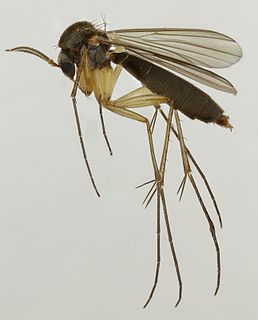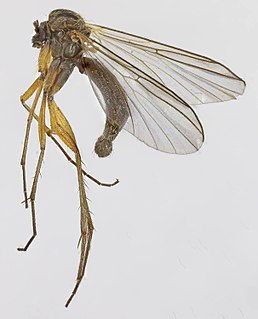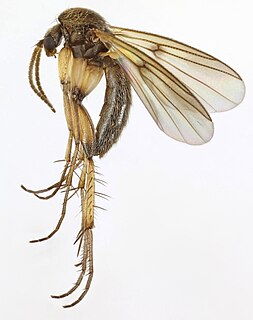Glowworm or glow-worm is the common name for various groups of insect larvae and adult larviform females that glow through bioluminescence. They include the European common glow-worm and other members of the Lampyridae, but bioluminescence also occurs in the families Elateridae, Phengodidae and Rhagophthalmidae among beetles; as well as members of the genera Arachnocampa, Keroplatus and Orfelia among keroplatid fungus gnats.

The Mycetophilidae are a family of small flies, forming the bulk of those species known as fungus gnats. About 3000 described species are placed in 150 genera, but the true number of species is undoubtedly much higher. They are generally found in the damp habitats favoured by their host fungi and sometimes form dense swarms.

Bolitophila is the sole living genus in the Bolitophilidae, a family of Diptera in the superfamily Sciaroidea, with around 40 Palaearctic and about 20 Nearctic species, and three species from the Oriental region (Taiwan). They are small (6–9 mm.)

The Ditomyiidae are a small family of flies (Diptera).They are found worldwide, most species are found in the Australasian and Neotropical realms. There are only two genera in Europe Ditomyia Winnertz, 1846 and Symmerus Walker, 1848 Ditomyia is found in Central Europe Symmerus in Northern Europe Symmerus is endemic to the Palaearctic.
Leptomorphus nebulosus is a species of fungus gnats in the family Mycetophilidae.
Leptomorphus is a genus of fungus gnats in the family Mycetophilidae. There are about 8 described species in Leptomorphus.
Sciophilinae is a subfamily of fungus gnats. There are at least 40 genera and 340 described species in Sciophilinae.

Boletina is a genus of fungus gnats in the family Mycetophilidae. There are at least 30 described species in Boletina.
Gnoristinae is a subfamily of fungus gnats in the family Mycetophilidae. There are about 6 genera and at least 4 described species in Gnoristinae.

Leia is a genus of fungus gnats in the family Mycetophilidae. There are more than 170 described species in Leia.

Leiinae is a subfamily of fungus gnats in the family Mycetophilidae. There are at least 4 genera and about 7 described species in Leiinae.
Sciophila is a genus of fungus gnats in the family Mycetophilidae. There are at least 50 described species in Sciophila.
Dubiraphia bivittata is a species of riffle beetle in the family Elmidae. It is found in North America.

Lygistorrhinidae is a family of long-beaked fungus gnats in the order Diptera. There are about 7 genera and at least 30 described species in Lygistorrhinidae.

Zygomyia is a genus of fungus gnats in the family Mycetophilidae. There are at least 80 described species in Zygomyia.

Mycetophilini is a tribe of fungus gnats in the family Mycetophilidae. There are about 8 genera and at least 220 described species in Mycetophilini.

Symmerus is a genus of fungus gnats and gall midges in the family Ditomyiidae. There are about five described species in Symmerus.
Leptomorphus hyalinus is a species of fungus gnats, insects in the family Mycetophilidae.
Leia ventralis is a species of fungus gnats in the family Mycetophilidae.
Leia varia is a species of fungus gnats in the family Mycetophilidae.










